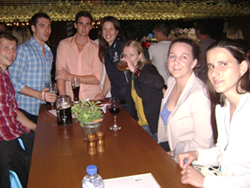London-UK, May 08, 2012: ESSA Conference, For the first time the ECSS together with Exercise & Sport Science Australia (ESSA) organised a poster exchange for young upcoming scientists in the field of sport and exercise science.
This year, Jelena Stosic from the University of Queensland (AUS) participated as as former Young Investigators Award (YIA) winner and ECSS-ESSA exchange delegate in the 5th international ESSA Conference at the Gold Coast, Queensland, Australia to present her YIA winning poster ‘Force synchrony enhances the stability of rhythmic multijoint arm coordination’.
Returning from the ESSA Conference Jelena shared valuable experiences and memories with the ECSS in her exchange report.
ECSS-ESSA exchange report
“Fifth international conference ESSA, entitled “From research to practice” was held from 19th – 21nd April 2012 on Gold Coast, Queensland, Australia. Participants were able to exchange scientific experience and to get to know the culture of the fifth continent.
As promised from the title, the conference gathered not only researchers, but also many practitioners such are exercise physiologist, exercise pathologist, coaches, personal trainers etc. I was completely amazed by this fact looking at the effort both sides have made to bridge science to practice, which for many of people seems unbridgeable. Many of the talks from researchers have overcome standard framework of presentations offering solutions that could have implications in the practical fields. Practitioners on the other hand have showed strong will for constant professional specialization which does not end after graduation. Apart from practitioners, there were researchers ranging from honours, master and PhD students, postdoctoral researchers and eminent professors. This type of conference is a reminder that no matter how someone’s work seems theoretical and away from practical application, everyone must aim to bridge their work to practise, to endeavour to find practical implications, because only in that way we can contribute to the growing knowledge of sport sciences.
Since I am a PhD student in Brisbane, only one hour was needed to the congress destination. In car driving, one hour passed quickly in talk with my peer colleagues from the same school (School of Human Movement Studies, UQ) Tania, Kate and Julie. I must say that this was my first time to be a guest of the hotel which was at the same the venue for the conference, which was really convenient. Being the guest of the hotel together with other invited speakers gave me a great feeling, the feeling of contribution to better science with my awarded work.
The three days conference consisted of many qualitative presentations of standard duration, and invited lectures. I would like to single out invited presentations because they give an overall understanding of the field of research, talking beyond single findings of studies, unifying past, present and future problems and offering directions for future research. From these longer talks, both researchers and practitioners can benefit. Researchers can get some of the brilliant ideas for some further research, they can re-evaluate some of the problems in own, existing research, while practitioners are encouraged to adopt some of their outcomes in its usual professional routine.
Apart from invited talks, all three days offered great oral short presentations. I was particularly interested in one talk about bi-functional muscles in cycling. Given my overall interested in multi-joint coordination, I was happy that I found out about NIRS technique that is helpful for physiological testing of bi-functional muscles. On the second day, there was a poster session. I had one hour opportunity to stand by my work and to answer to many questions that interested participants have had after reading my poster. I am happy that I was able to explain my study outcomes to researchers and practitioners, bringing the outcomes to their practical application. The fact that Australia is an excellent and sporty country was shown at the closing banquet where all the participants could enjoy in excellent gymnastics performance of the local Queensland gymnastics club. The conference ended with closing dinner where excellent band was playing live music.
At the end, I would like to greatly thank ECSS and ESSA for giving me chance to present my work at 5th ESSA conference, from which I benefit in getting new experience and contacts that may be useful for future collaborations and job offers. I hope I will justify this great honour and trust which the ECSS organization gave to me, and that I will continue to contribute to the highest quality and scientific progress of the ECSS by presenting my research on future ECSS conferences.”



Leave a Reply
You must be logged in to post a comment.